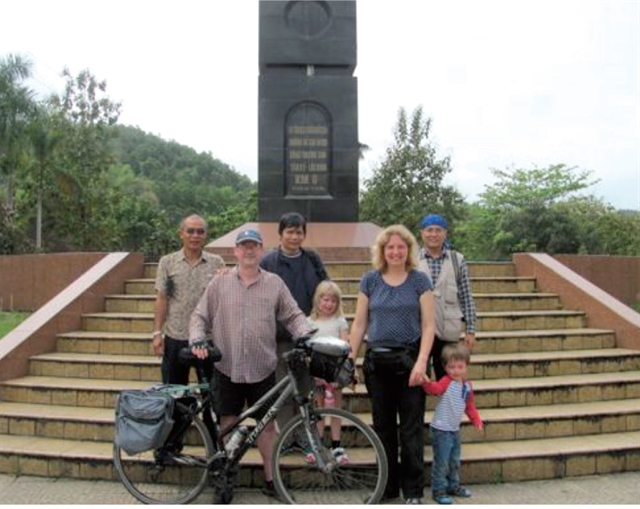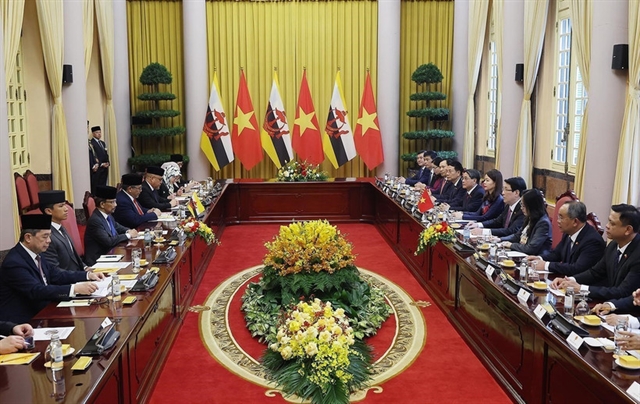 Sunday/Weekend
Sunday/Weekend

.jpg) |
| The cover of 'War Site Discoveries of Vietnam' by Virginia Morris, Lê Đỗ Huy and Clive A. Hills. Photo courtesy of Thế Giới (World) Publishers |
by Lina Phạm
War Site Discoveries of Vietnam by Virginia Morris, Lê Đỗ Huy and Clive A. Hills is a captivating and immersive journey into Việt Nam's wartime history, offering a unique blend of personal narrative, historical insight, and first-hand experiences.
Through interviews with veterans, visits to historic battlegrounds, and detailed explorations of significant yet often overlooked locations, the authors bring the country's complex wartime history to life.
One of the book's strengths lies in its ability to interweave the personal experiences of the authors with the broader historical narrative.
Morris recounts her extensive travels across Việt Nam and Laos over a period of two decades. Her encounters with war veterans and legendary figures like General Võ Nguyên Giáp, or the architect of Hồ Chí Minh Trail - Lieutenant General Đồng Sỹ Nguyên lend the book an authenticity and depth that set it apart from typical historical accounts.
 |
| A typical waterway of Xẻo Quýt Resistance Base. — Photo by Clive A. Hills |
Morris's journey through battle sites of Việt Nam helped answer the question of how a small, seemingly under-equipped Vietnamese army was able to defeat powerful forces like the US military.
Along with Huy’s research expertise and Hills's photography, this book offers readers a multi-faceted look at a crucial period in Vietnamese history.
Each chapter is dedicated to a different war zone or battleground, from the streets of Hà Nội where the August 1945 Revolution took root to the Hồ Chí Minh Trail and the base areas of the Việt Cộng.
The authors offer detailed descriptions of these locations, often accompanied by maps and photographs that help situate readers in the geographic and historical context.
The Hồ Chí Minh Trail, both on land and via the sea route, receives special attention, as the authors travel along its many paths to document its significance as a lifeline for the North Vietnamese forces. This chapter, in particular, underscores the book's theme of discovery, as the authors uncover sites that remain relatively unknown to the broader public.
A key highlight of War Site Discoveries of Vietnam is the personal testimonies of war veterans. These first-hand accounts are invaluable, offering perspectives from individuals who lived through the conflict and played a direct role in Việt Nam's fight for independence. These veterans' stories are woven seamlessly into the broader historical context, providing readers with both a macro and micro view of the events that shaped modern Việt Nam.
 |
| 30 March 2015, at KM 0, the symbolic start of the Hồ Chí Minh Trail, from left: Phan Mạnh Hùng (friend and guide, in 2003 and 2015 travelled the Hồ Chí Minh Trail with Virginia Morris and Clive A. Hills), Clive A. Hills (photographer), Lê Đỗ Huy (researcher and author), Bluebelle (daughter of Virginia and Clive), Virginia Morris (researcher and author), Lưu Phương Bình (a friend who contributed to the book), and Albion (son of Virginia and Clive). Photo by Clive A. Hills) |
The emotional impact of the book is further heightened by the authors' personal reflections. Morris, Hills, and Huy are not merely observers; they are active participants in the discovery process. Their emotional connection to the places they visited and the people they met is evident throughout the book, making the narrative both engaging and heartfelt.
The inclusion of Vietnamese co-author Huy lends credibility to the narrative, ensuring that the Vietnamese perspective is adequately represented.
Morris’s academic background and previous work on Southeast Asian conflicts add depth to the historical analysis.
Hills, an experienced photographer, contributes a visual dimension that complements the text, making the book both informative and visually engaging.
War Site Discoveries of Vietnam doesn’t shy away from addressing the lasting effects of war. The authors explore how these historical sites serve as reminders of the human cost of conflict. By visiting these places and recounting their histories, Morris, Huy and Hills underscore the importance of remembering and learning from the past.
The book also examines how these sites have been preserved or altered over time. In doing so, it raises questions about the role of memory and history in a country’s national identity. For some, these places are sacred spaces of remembrance; for others, they are painful reminders that should be left in the past. The authors handle these complex themes with sensitivity, allowing readers to draw their own conclusions.
In summary, War Site Discoveries of Vietnam serves as both a historical record and a personal journey, bridging past and present in a meaningful way.
 |
| These long straight canals are typical in the Mekong Delta. During the anti-French war, in areas that did not have waterways, small channels were dug by Vietnamese resistance force, and named Resistance Canals. Photo by Clive A. Hills |
For history enthusiasts, the book offers a fresh perspective on the Việt Nam War, providing insights that go beyond textbooks and documentaries. For travellers, it acts as a guide to a unique aspect of Việt Nam's landscape, encouraging a deeper understanding of the country’s history.
Whether you’re a scholar, a traveller, or someone with an interest in history, this book offers a profound and moving experience and hopefully understanding of the Việt Nam War and its legacy. VNS




